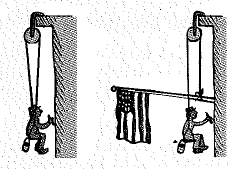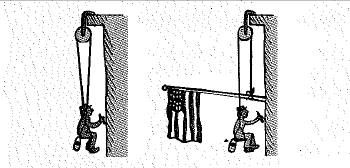
Concept explainers
Harry the painter swings year after year from his bosun’s chair. His weight is 500 N and the rope, unknown to him, has a breaking point of 300 N. Why doesn’t the rope break when he is supported as shown at the left? One day Harry is painting near a flag-pole, and, for a change, he ties the free end of the rope to the flagpole instead of to his chair as shown at the right. Why did Harry end up taking his vacation early?

To explain:The reason for not breaking of rope when person H is supported.
Also, the reason for ending up by taking his vacation early.
Answer to Problem 30A
The rope doesn’t break due to the tension on the string as it is below the breaking point of the rope,
Person H falls down, so he end up taking his vacation early.
Explanation of Solution
Given:
The weight of Harry is
The breaking point of the rope is
The given figure is shown below.

Formula used:
The expression for the weight is,
Here,
Calculation:
Person H is supported by two strings in the given left Figure.
The tension on the string is,
The tension on the string is below the breaking point of the rope,
Hence, the rope doesn’t break due to the tension on the string is below the breaking point of the rope,
Person H ties the free end of the rope to the flag pole instead of to his chair. So he is supported by a string in the given right Figure.
The tension on the string is,
The tension on the string is beyond the breaking point of the rope,
Chapter 2 Solutions
Conceptual Physics C2009 Guided Reading & Study Workbook Se
Additional Science Textbook Solutions
Cosmic Perspective Fundamentals
College Physics: A Strategic Approach (3rd Edition)
Physics for Scientists and Engineers: A Strategic Approach, Vol. 1 (Chs 1-21) (4th Edition)
Chemistry
Campbell Biology: Concepts & Connections (9th Edition)
Human Anatomy & Physiology (2nd Edition)
 College PhysicsPhysicsISBN:9781305952300Author:Raymond A. Serway, Chris VuillePublisher:Cengage Learning
College PhysicsPhysicsISBN:9781305952300Author:Raymond A. Serway, Chris VuillePublisher:Cengage Learning University Physics (14th Edition)PhysicsISBN:9780133969290Author:Hugh D. Young, Roger A. FreedmanPublisher:PEARSON
University Physics (14th Edition)PhysicsISBN:9780133969290Author:Hugh D. Young, Roger A. FreedmanPublisher:PEARSON Introduction To Quantum MechanicsPhysicsISBN:9781107189638Author:Griffiths, David J., Schroeter, Darrell F.Publisher:Cambridge University Press
Introduction To Quantum MechanicsPhysicsISBN:9781107189638Author:Griffiths, David J., Schroeter, Darrell F.Publisher:Cambridge University Press Physics for Scientists and EngineersPhysicsISBN:9781337553278Author:Raymond A. Serway, John W. JewettPublisher:Cengage Learning
Physics for Scientists and EngineersPhysicsISBN:9781337553278Author:Raymond A. Serway, John W. JewettPublisher:Cengage Learning Lecture- Tutorials for Introductory AstronomyPhysicsISBN:9780321820464Author:Edward E. Prather, Tim P. Slater, Jeff P. Adams, Gina BrissendenPublisher:Addison-Wesley
Lecture- Tutorials for Introductory AstronomyPhysicsISBN:9780321820464Author:Edward E. Prather, Tim P. Slater, Jeff P. Adams, Gina BrissendenPublisher:Addison-Wesley College Physics: A Strategic Approach (4th Editio...PhysicsISBN:9780134609034Author:Randall D. Knight (Professor Emeritus), Brian Jones, Stuart FieldPublisher:PEARSON
College Physics: A Strategic Approach (4th Editio...PhysicsISBN:9780134609034Author:Randall D. Knight (Professor Emeritus), Brian Jones, Stuart FieldPublisher:PEARSON





